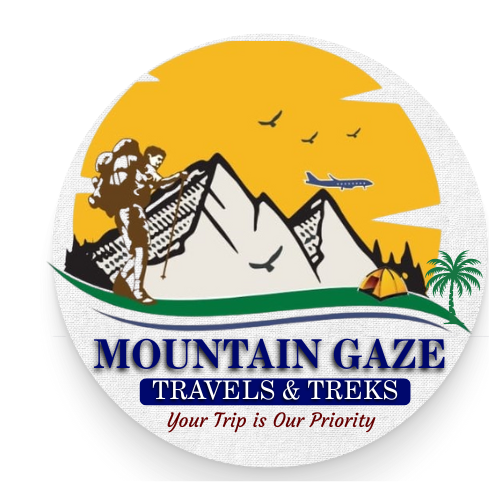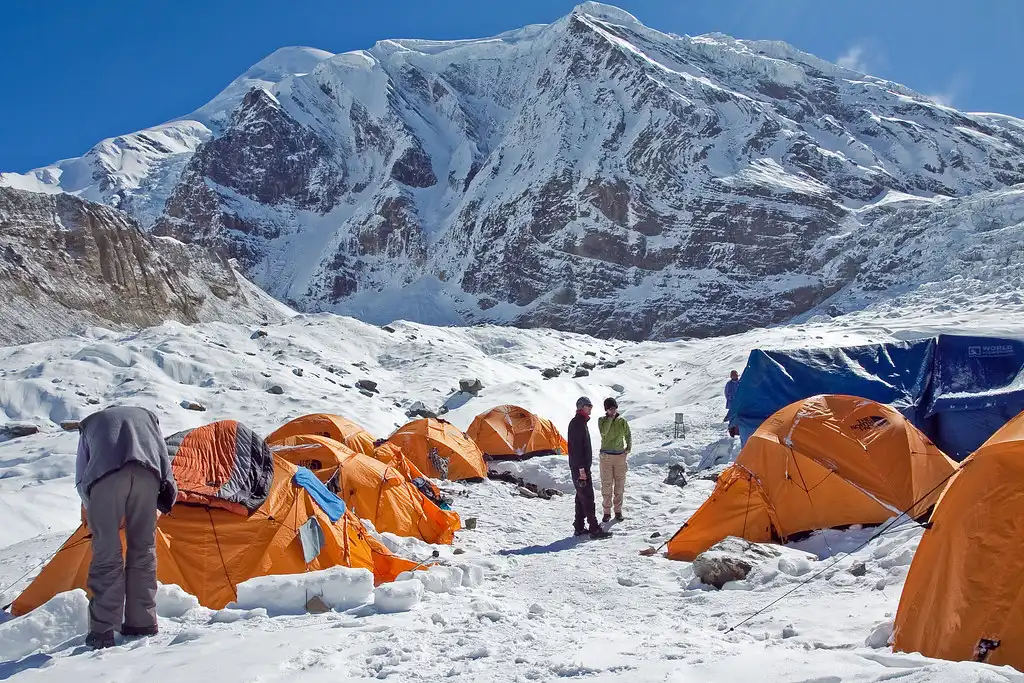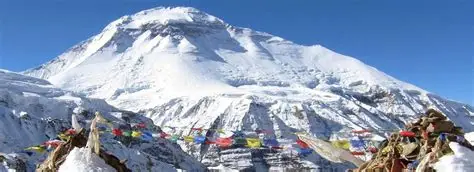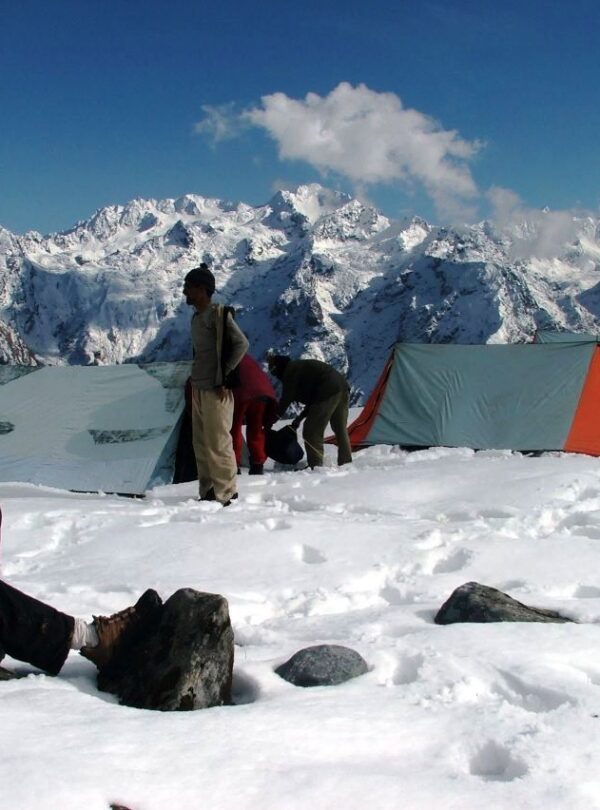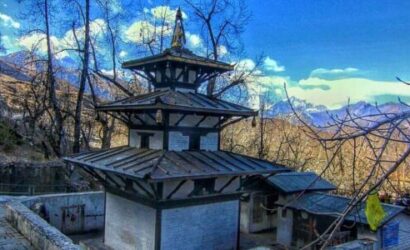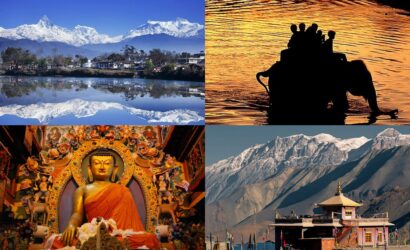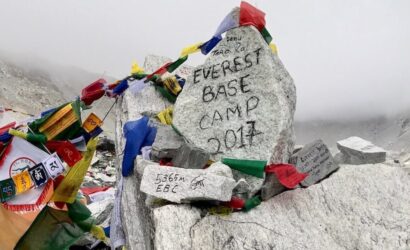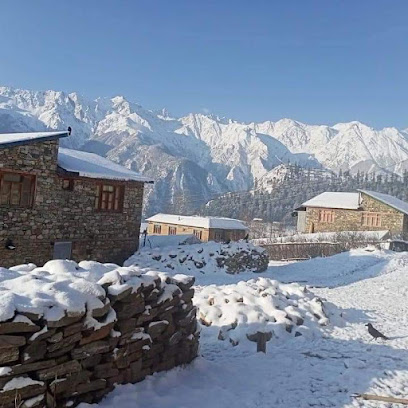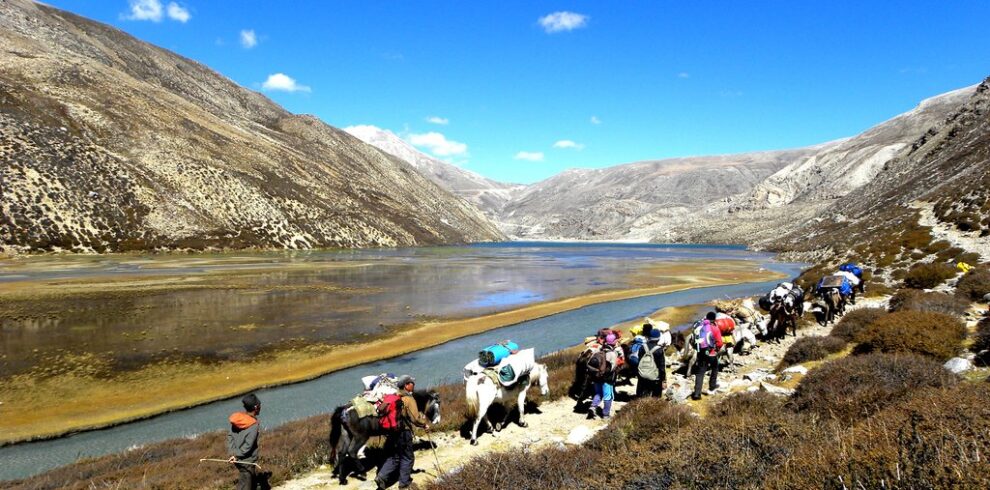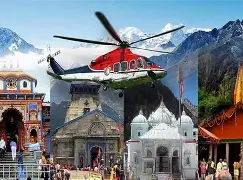Duration – 17N/ 18D Nepal
The trek starts from Beni, where you will trek towards the small village of Tatopani, which is known for its natural hot springs. From Tatopani, you will trek to Dharapani, which is a small village situated at an altitude of 1,560m. From Dharapani, the trail leads to Muri, where you will start to notice the changes in the landscape. The forested areas will give way to more rugged terrain, and you will start to see the snow-capped peaks of the Dhaulagiri range.The next stop is Boghara, which is a small village located at an altitude of 2,080m. From here, you will trek to Dobang, which is situated at an altitude of 2,520m. The trail to Dobang is quite steep, and you will need to be in good physical shape to tackle it. As you keep going the next stop on the trek is the Italian Base Camp, which is situated at an altitude of 3,660m. The base camp is named after the Italian team that first climbed Dhaulagiri in 1960. From here, you will trek to the Glacier Camp, which is situated at an altitude of 4,200m.The final destination of the trek is Dhaulagiri Base Camp, which is situated at an altitude of 4,750m. At the Dhaulagiri Base Camp, you will be rewarded with breathtaking views of the Dhaulagiri mountain range, including Dhaulagiri I(8167m), II(7751m), III(7715m), and IV(7715m). You can also explore the surrounding glaciers, icefalls, and high-altitude lakes.
Overview
The Dhaulagiri Base Camp Trek is a challenging and equally fruitful adventure that leads you through some of the most rural and stunning landscapes of the Himalayas. The trek leads you to the base of the world’s seventh-highest mountain, Dhaulagiri, which stands tall at an elevation of 8,167 meters.
The trek begins in the town of Beni, located in the western part of Nepal. From there, you will follow the Myagdi Khola River and trek through dense forests, terraced fields, and charming villages inhabited by Gurung, Magar, and Thakali people. The trail is steep and rugged in some parts, but the views of snow-capped peaks and deep valleys make every step worth it.The Dhaulagiri Base Camp Trek is a challenging and equally fruitful adventure that leads you through some of the most rural and stunning landscapes of the Himalayas. The trek leads you to the base of the world’s seventh-highest mountain, Dhaulagiri, which stands tall at an elevation of 8,167 meters.
The trek begins in the town of Beni, located in the western part of Nepal. From there, you will follow the Myagdi Khola River and trek through dense forests, terraced fields, and charming villages inhabited by Gurung, Magar, and Thakali people. The trail is steep and rugged in some parts, but the views of snow-capped peaks and deep valleys make every step worth it.
The trek starts from Beni, where you will trek towards the small village of Tatopani, which is known for its natural hot springs. From Tatopani, you will trek to Dharapani, which is a small village situated at an altitude of 1,560m. From Dharapani, the trail leads to Muri, where you will start to notice the changes in the landscape. The forested areas will give way to more rugged terrain, and you will start to see the snow-capped peaks of the Dhaulagiri range.The next stop is Boghara, which is a small village located at an altitude of 2,080m. From here, you will trek to Dobang, which is situated at an altitude of 2,520m. The trail to Dobang is quite steep, and you will need to be in good physical shape to tackle it. As you keep going the next stop on the trek is the Italian Base Camp, which is situated at an altitude of 3,660m. The base camp is named after the Italian team that first climbed Dhaulagiri in 1960. From here, you will trek to the Glacier Camp, which is situated at an altitude of 4,200m.The final destination of the trek is Dhaulagiri Base Camp, which is situated at an altitude of 4,750m. At the Dhaulagiri Base Camp, you will be rewarded with breathtaking views of the Dhaulagiri mountain range, including Dhaulagiri I(8167m), II(7751m), III(7715m), and IV(7715m). You can also explore the surrounding glaciers, icefalls, and high-altitude lakes.
After spending some time at the base camp, you will trek towards the Hidden Valley via the French Pass, which is situated at an altitude of 5,360m. The pass is quite steep, and you will need to be in good physical shape to tackle it.From the Hidden Valley, you will trek to Yak Kharka via the Dhampus Pass, which is situated at an altitude of 5,240m. The pass offers stunning views of the Annapurna range.
From Marpha, you will take a scenic drive to Pokhara, where you can relax and unwind after the trek.
Best time for Dhaulagiri Base Camp Trek
The best time to travel to Dhaulagiri Base Camp is during the spring and autumn seasons. In spring (March to May), the weather is generally stable and dry, and the area is covered with blooming rhododendron flowers, adding to the beauty of the trek. The temperature is moderate during this time, making trekking comfortable.
In autumn (September to November), the skies are clear, and the views of the mountains are breathtaking. The temperature is also moderate, making it an ideal time for trekking. The weather conditions are generally stable during this time, and the trails are less crowded compared to the peak season, allowing trekkers to enjoy a more peaceful trekking experience. Some people also trek during winter (early December to late January) but in winter the temperature can drop to minus and the snowy way can make your trek miserable.
So if you don’t have prior experience of trekking in snow it is better to avoid the winter season.
However, it’s important to note that weather conditions in the Himalayas can be unpredictable, and it’s always best to check the weather forecast before embarking on the trek. Additionally, it’s always a good idea to have appropriate gear and clothing for the trek, regardless of the time of year.
Accommodation in Dhaulagiri Base Camp Trek
Camping is a common and popular mode of accommodation during the Dhaulagiri Base Camp Trek in Nepal. This is because there are no lodges or tea houses along the trail, and camping provides the flexibility and independence to explore the region at your own pace.
Camping allows you to enjoy the stunning natural surroundings of the Dhaulagiri region, including its mountains, glaciers, and alpine meadows. It also provides a more immersive experience of the local culture and way of life, as you will be interacting with locals and experiencing their hospitality firsthand.
To camp during the Dhaulagiri Base Camp Trek, we will need to bring your own camping gear, including a tent, sleeping bag, sleeping mat, and cooking equipment. If you bring your own food, make sure it is lightweight and easy to cook, such as dehydrated meals or instant noodles. You will also need to bring a stove and fuel to cook with. We as your traveling companion will provide all the food and cooking equipment for you.
You will also need to properly dispose of all your waste, including food scraps and human waste, and follow the Leave No Trace principles to minimize your impact on the environment.
Camping can be a rewarding and memorable experience during the Dhaulagiri Base Camp Trek, but it requires proper planning, preparation, and caution to ensure a safe and enjoyable trip.
Food and Beverages during Dhaulagiri Base Camp Trek
Since there are no lodges or tea houses along the Dhaulagiri Base Camp Trek, the only options for food are either to bring our own food and prepare meal for you throughout the trek.You will get tea or coffee, eggs with toast, buckwheat pancakes, porridge, rice, lentil soup and vegetable curry, sandwiches, thukpa ,noodles, etc for the meals. Here is what it looks like on a daily basis.
Breakfast:
- Porridge, muesli, or eggs with toast, buckwheat pancakes
- Tea or coffee
Lunch:
- Dal bhat (rice, lentil soup, and vegetable curry)
- Fried rice or noodles
- Sandwiches or wraps
- Tea or coffee
- Thukpa (typical Nepali dish like noodles)
Dinner:
- Dal bhat (rice, lentil soup and vegetable curry)
- Vegetable curry
- Momo (Nepali dumplings stuffed with meat or vegetables)
- Pasta
- Apple pie ( if available)
- Noodles, Thukpa
In addition to these main meals, snacks such as biscuits, chocolate bars, and energy bars are also recommended to keep up energy levels during the trek. It’s important to note that drinking water must be purified or boiled before consumption, and bottled water is not readily available along the trekking route.
Overall, the food options during the Dhaulagiri Base Camp Trek are limited, but you can still find a variety of meals to sustain yourself during the trek. If you are bringing your own food, make sure to choose lightweight and easy-to-cook meals that provide enough calories to keep you energized.
People and Culture in Dhaulagiri Base Camp Trek
You can find various ethnic tribes and people of different cultures on this trek. Some of them are:
- Gurung people: The Gurung people are an ethnic group who primarily live in the Annapurna and Dhaulagiri regions of Nepal. They are known for their bravery, loyalty, and military service. Many Gurungs work as guides, porters, or cooks during trekking expeditions. They are also skilled craftsmen, known for their weaving and basket making.
- Thakali people: The Thakali people are another ethnic group who live in the Dhaulagiri region. They are known for their entrepreneurial spirit, and many run guesthouses, restaurants, and shops along the trekking routes. Thakali cuisine is also popular among trekkers, and includes dishes like Thakali dal bhat, buckwheat pancakes, and apple pie.
- Tibetan refugees: The Dhaulagiri region is home to several Tibetan refugee settlements, where you can learn about Tibetan culture and religion. Many of these settlements have monasteries and nunneries, where you can witness daily rituals and ceremonies.
- Hindu and Buddhist culture: Nepal is a country with a rich and diverse religious heritage, and the Dhaulagiri region is no exception. Along the trekking route, you will encounter Hindu and Buddhist shrines, temples, and monasteries, which provide insight into the spiritual beliefs and practices of the local people.
- Festivals and celebrations: The Dhaulagiri region is home to several festivals and celebrations throughout the year, including the Mani Rimdu festival, which is celebrated by the Sherpa people in the Solu-Khumbu region. This festival involves traditional dances, rituals, and ceremonies, and is a colorful and joyous occasion.
Overall, the people and culture of the Dhaulagiri Base Camp Trek offer a fascinating glimpse into the rich and diverse heritage of Nepal. By interacting with the locals and learning about their traditions, you can gain a deeper appreciation for the beauty and complexity of this incredible country.
Dhaulagiri Base Camp Trek Difficulty
The Dhaulagiri Base Camp trek is considered a challenging trek and is suitable for experienced trekkers. It involves hiking through rugged terrain, crossing high mountain passes, and encountering unpredictable weather conditions. Altitude sickness is also a risk, as the trek reaches heights over 4,000meters and reaches an highest elevation of 5,360 meters at one point.
The trail requires a good level of physical fitness, endurance, and acclimatization to the altitude. Trekkers are recommended to prepare themselves with regular exercise and training prior to the trek, and to take adequate rest and hydration during the journey. The trek also requires camping and self-sufficiency, as there are limited facilities along the way.
Overall, the Dhaulagiri Base Camp trek is a challenging but rewarding adventure for experienced trekkers who are up for the physical and mental demands of the journey.
Permits for Dhaulagiri Base Camp Trek
To trek to Dhaulagiri Base Camp, you will need to obtain a permit from the government of Nepal. The permit is issued by the Department of Immigration in Kathmandu or Pokhara.
The permit requirements and fees vary depending on the trekking season and your nationality. Generally, you will need to provide your passport and a copy of your trekking itinerary.
In addition to the permit, you may also need to obtain a TIMS (Trekkers’ Information Management System) card, which is a mandatory permit for all trekkers in Nepal. TIMS cards are issued by the Nepal Tourism Board or the Trekking Agencies’ Association of Nepal (TAAN).
Our team at Mountain Gaze will handle your hassle for the permit. You will need to provide us:
*Original Passport
*Visa having validity till your time of tour
*Two passport size photos
*Cash in Nepali rupees for permit fees
The trek offers breathtaking views of Dhaulagiri(8167m), the seventh highest mountain in the world, as well as other peaks in the Dhaulagiri range.
- The trek includes various high altitude passes such starting from Hidden Valley(5,200m) and French Pass(5,360m)
- Along the way, you'll have the opportunity to interact with the local communities and experience their unique culture and way of life.
- The trek is physically demanding, with steep ascents and descents, river crossings, and rugged terrain.
- The Dhaulagiri Base Camp trek is a remote wilderness trek that takes you far from the crowds and into some of the most pristine and untouched landscapes in the Himalayas.
- The trek also includes a visit to Tatopani, a natural hot spring where you can relax and soak your weary muscles.
